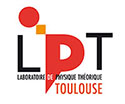Loading...
Derniers dépôts, tout type de documents
The subject of the thesis focuses on new approximations studied in a formalism based on a perturbation theory allowing to describe the electronic properties of many-body systems in an approximate way. We excite a system with a small disturbance, by sending light on it or by applying a weak electric field to it, for example and the system "responds" to the disturbance, in the framework of linear response, which means that the response of the system is proportional to the disturbance. The goal is to determine what we call the neutral excitations or bound states of the system, and more particularly the single excitations. These correspond to the transitions from the ground state to an excited state. To do this, we describe in a simplified way the interactions of the particles of a many-body system using an effective interaction that we average over the whole system. The objective of such an approach is to be able to study a system without having to use the exact formalism which consists in diagonalizing the N-body Hamiltonian, which is not possible for systems with more than two particles.
We present the multi-channel Dyson equation that combines two or more many-body Green's functions to describe the electronic structure of materials. In this thesis, we use it to model photoemission spectra by coupling the one-body Green's function with the three-body Green's function and to model neutral excitation by coupling the two-body Green's function with the four-body Green's function . We demonstrate that, unlike methods using only the one-body Green's function, our approach puts the description of quasiparticles and satellites on an equal footing. We propose a multi-channel self-energy that is static and only contains the bare Coulomb interaction, making frequency convolutions and self-consistency unnecessary. Despite its simplicity, we demonstrate with a diagrammatic analysis that the physics it describes is extremely rich. Finally, we present a framework based on an effective Hamiltonian that can be solved for any many-body system using standard numerical tools. We illustrate our approach by applying it to the Hubbard dimer and show that it is exact both at 1/4 and 1/2 filling.
We present the second release of the real-time time-dependent density functional theory code “Quantum Dissipative Dynamics” (QDD). It augments the first version [1] by a parallelization on a GPU coded with CUDA fortran. The extension focuses on the dynamical part only because this is the most time consuming part when applying the QDD code. The performance of the new GPU implementation as compared to OpenMP parallelization has been tested and checked on a couple of small sodium clusters and small covalent molecules. OpenMP parallelization allows a speed-up by one order of magnitude in average, as compared to a sequential computation. The use of a GPU permits a gain of an additional order of magnitude. The performance gain outweighs even the larger energy consumption of a GPU. The impressive speed-up opens the door for more demanding applications, not affordable before
We present the multi-channel Dyson equation that combines two or more many-body Green's functions to describe the electronic structure of materials. In this work we use it to model photoemission spectra by coupling the one-body Green's function with the three-body Green's function. We demonstrate that, unlike methods using only the one-body Green's function, our approach puts the description of quasiparticles and satellites on an equal footing. We propose a multi-channel self-energy that is static and only contains the bare Coulomb interaction, making frequency convolutions and self-consistency unnecessary. Despite its simplicity, we demonstrate with a diagrammatic analysis that the physics it describes is extremely rich. Finally, we present a framework based on an effective Hamiltonian that can be solved for any many-body system using standard numerical tools. We illustrate our approach by applying it to the Hubbard dimer and show that it is exact both at 1/4 and 1/2 filling.
Sujets
3115ee
Effets dissipatifs
Metal cluster
Clusters
3620Kd
Irradiation moléculaire
Multirefence methods
Atom laser
Molecular dynamics
Instabilité
Greens function methods
Electronic properties of metal clusters and organic molecules
Energy spectrum
Nickel oxide
Electron correlation
High intensity lasers
Optical response
Oxyde de nickel
Corrélations
Photon interactions with free systems
Hierarchical method
Hierarchical model
Fonction de Green
Méthodes des fonctions de Green
Deposition dynamics
Diffusion
Méthode multiréférence
Interactions de photons avec des systèmes libres
Semiclassic
Modèle de Hubbard
Nucléaire
Neutron Induced Activation
Collision frequency
Mean-field
Collisional time-dependent Hartree-Fock
Correction d'auto-interaction
Fission
Density Functional Theory
Electronic properties of sodium and carbon clusters
Photo-Electron Spectrum
3640Cg
Time-dependent density-functional theory
Au-delà du champ moyen
Laser
Théorie de la fonctionnelle de la densité
Nuclear
Photo-electron distributions
Electron-surface collision
Coulomb explosion
Agregats
GW approximation
Matel clusters
Activation neutronique
Electronic emission
Lasers intenses
Extended time-dependent Hartree-Fock
Méchanismes d'ionisation
Matrice densité
Neutronic
Hubbard model
Numbers 3360+q
CAO
Nanoplasma
Aggregates
FOS Physical sciences
Landau damping
Angle-resolved photoelectron spectroscopy
Deposition
Molecules
Relaxation
Dynamique moléculaire
Embedded metal cluster
Green's function
Density-functional theory
Coulomb presssure
Electron emission
MBPT
Agrégats
Molecular irradiation
Instability
Dissipation
Dissipative effects
Electronic excitation
Neutronique
Electric field
Monte-Carlo
Inverse bremsstrahlung collisions
Champ-moyen
Approximation GW
Dynamics
Corrélation forte
Corrélations dynamiques
Damping
Environment
Ar environment
TDDFT
Chaos
Explosion coulombienne
Metal clusters
Ionization mechanisms
